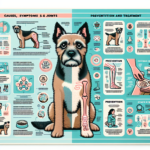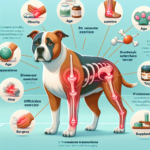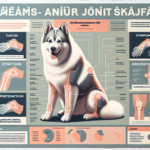Border Terrier Joint Pain: Causes, Symptoms, Prevention, and Treatment

Introduction
Overview of Border Terrier: The Border Terrier is a small, energetic breed known for its distinctive otter-shaped head and wiry coat. Originating from the border region between England and Scotland, this breed was initially developed for hunting foxes and other small game. Border Terriers are characterized by their tenacity, intelligence, and affectionate nature, making them excellent companions and family pets.
General Health Concerns: Like many breeds, Border Terriers are prone to certain health issues. Common concerns include dental problems, allergies, and heart conditions. However, one of the most significant health issues that can affect Border Terriers is joint pain, which can severely impact their quality of life.
Importance of Joint Health in Border Terriers: Joint health is crucial for Border Terriers due to their active and energetic nature. These dogs thrive on physical activity, and any joint-related issues can hinder their ability to run, play, and engage in their favorite activities. Maintaining joint health is essential to ensure that Border Terriers remain happy, healthy, and mobile throughout their lives.
Breed-Specific Joint Pain Risks
Genetic Predisposition
Border Terriers, like many purebred dogs, can be genetically predisposed to certain joint-related issues. Conditions such as hip dysplasia, elbow dysplasia, and arthritis are more common in this breed. Hip dysplasia occurs when the hip joint does not fit properly into the hip socket, leading to pain and mobility issues. Elbow dysplasia involves abnormal development of the elbow joint, causing lameness and discomfort. Arthritis, a degenerative joint disease, can also affect Border Terriers, leading to chronic pain and stiffness.
Age-Related Risks
As Border Terriers age, the risk of developing joint pain increases. While younger dogs may not show immediate signs of joint issues, the wear and tear on their joints over time can lead to problems in their senior years. Owners should be vigilant about monitoring their dogs for signs of joint pain as they reach middle age, typically around 7-8 years old, and into their senior years.
Activity Level and Joint Stress
Border Terriers are known for their high energy levels and love for physical activity. Whether they are participating in agility courses, hunting, or simply playing fetch, their joints are subjected to significant stress. While regular exercise is essential for their overall health, excessive or high-impact activities can exacerbate joint issues. Owners should strike a balance between keeping their dogs active and avoiding activities that may strain their joints.
Common Symptoms of Joint Pain in Border Terriers
General Symptoms
- Limping: One of the most noticeable signs of joint pain is limping or favoring one leg over another.
- Stiffness: Dogs with joint pain may exhibit stiffness, especially after resting or sleeping.
- Reluctance to Move: A dog that is hesitant to jump, climb stairs, or engage in physical activities may be experiencing joint pain.
- Decreased Activity: A reduction in overall activity levels or a lack of enthusiasm for play can indicate joint discomfort.
- Behavioral Changes: Irritability, aggression, or withdrawal can be signs of chronic pain.
Breed-Specific Symptoms
In Border Terriers, joint pain may manifest in specific ways. Due to their hunting background, they may show a reluctance to dig or chase after small animals, activities they typically enjoy. Additionally, they may exhibit a noticeable change in their gait, such as a “bunny hop” when running, which can indicate hip dysplasia.
When to Consult a Vet
If you notice any of the above symptoms in your Border Terrier, it is essential to consult a veterinarian promptly. Early diagnosis and intervention can significantly improve the prognosis and quality of life for dogs with joint pain. Regular veterinary check-ups are also crucial for monitoring joint health and catching any issues early.
Preventive Measures for Joint Health
Exercise Recommendations
Maintaining an appropriate exercise routine is vital for Border Terriers. Low-impact activities such as walking, swimming, and controlled play sessions are excellent for keeping their joints healthy. Avoid high-impact activities like excessive jumping or running on hard surfaces, which can strain their joints. Regular, moderate exercise helps maintain muscle strength and joint flexibility.
Dietary Suggestions
A balanced diet rich in essential nutrients can support joint health. Consider incorporating foods or supplements that contain glucosamine, chondroitin, and omega-3 fatty acids, which are known to promote joint health. Consult your veterinarian for specific dietary recommendations tailored to your Border Terrier’s needs.
Weight Management
Maintaining a healthy weight is crucial for reducing joint stress. Excess weight can exacerbate joint pain and lead to other health issues. Monitor your dog’s weight regularly and adjust their diet and exercise routine as needed to keep them at an optimal weight.
Early Screening and Monitoring
Early screening for joint issues can help catch problems before they become severe. Regular veterinary check-ups should include joint assessments, especially as your Border Terrier ages. Your vet may recommend specific screening tests, such as X-rays, to evaluate joint health and detect any early signs of dysplasia or arthritis.
Treatment Options for Joint Pain
Non-Surgical Treatments
For mild to moderate joint pain, non-surgical treatments can be effective. These may include:
- Medications: Nonsteroidal anti-inflammatory drugs (NSAIDs) can help reduce pain and inflammation. Your vet may also prescribe pain relievers or joint supplements.
- Physical Therapy: Physical therapy exercises can improve joint mobility and strengthen muscles. Hydrotherapy, or water-based exercises, can be particularly beneficial.
- Lifestyle Adjustments: Modifying your dog’s activity level and providing a comfortable living environment can help manage joint pain.
Surgical Options
In severe cases of joint pain, surgical intervention may be necessary. Common surgical options for Border Terriers include:
- Hip Replacement: Total hip replacement can be an effective solution for severe hip dysplasia.
- Arthroscopy: Minimally invasive surgery to remove damaged tissue or repair joint structures.
- Joint Fusion: In cases of severe arthritis, joint fusion can stabilize the joint and reduce pain.
Alternative Therapies
Alternative therapies can complement traditional treatments and provide additional relief. These may include:
- Acupuncture: Acupuncture can help reduce pain and improve joint function.
- Hydrotherapy: Water-based exercises can improve mobility and reduce joint stress.
- Massage: Regular massage can alleviate muscle tension and improve circulation.
Lifestyle and Management Tips
Daily Care Routine
A consistent daily care routine can help manage joint pain in Border Terriers. This may include:
- Providing regular, low-impact exercise to maintain joint flexibility.
- Feeding a balanced diet with joint-supporting nutrients.
- Administering any prescribed medications or supplements.
- Monitoring your dog’s weight and adjusting their diet as needed.
Modifying the Home Environment
Making your home more comfortable for a dog with joint pain can significantly improve their quality of life. Consider the following modifications:
- Installing ramps or steps to help your dog access furniture or climb stairs.
- Providing orthopedic beds to support their joints while resting.
- Ensuring that food and water bowls are at a comfortable height to reduce strain on their neck and joints.
Long-Term Management
Long-term management of joint pain involves ongoing care and monitoring. Regular veterinary check-ups, consistent exercise, and a balanced diet are essential components. Additionally, staying informed about new treatments and therapies can help you provide the best care for your Border Terrier.
FAQs About Border Terriers and Joint Pain
What are the early signs of joint pain in Border Terriers?
Early signs of joint pain in Border Terriers include limping, stiffness, reluctance to move, decreased activity levels, and behavioral changes such as irritability or withdrawal.
Can joint pain in Border Terriers be prevented?
While it may not be possible to prevent joint pain entirely, taking preventive measures such as maintaining a healthy weight, providing regular low-impact exercise, and feeding a balanced diet with joint-supporting nutrients can significantly reduce the risk.
Are there specific exercises that are better for Border Terriers with joint pain?
Yes, low-impact exercises such as walking, swimming, and controlled play sessions are ideal for Border Terriers with joint pain. Avoid high-impact activities that can strain their joints.
What dietary supplements can help support joint health in Border Terriers?
Supplements containing glucosamine, chondroitin, and omega-3 fatty acids can support joint health in Border Terriers. Consult your veterinarian for specific recommendations.
When should I consider surgery for my Border Terrier’s joint pain?
Surgery should be considered if non-surgical treatments are ineffective and your dog is experiencing severe pain or mobility issues. Consult your veterinarian to discuss the best surgical options for your dog’s specific condition.
Conclusion
Joint pain is a significant concern for Border Terriers, but with proper care and attention, it can be managed effectively. By understanding the causes, symptoms, preventive measures, and treatment options, owners can ensure their Border Terriers lead active, healthy, and pain-free lives. Regular veterinary check-ups, a balanced diet, appropriate exercise, and a comfortable living environment are essential components of maintaining joint health. By taking proactive steps, you can help your Border Terrier enjoy a happy and active life despite the challenges of joint pain.




